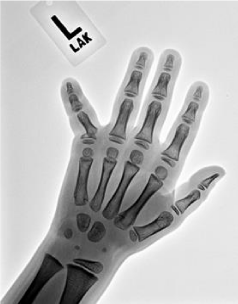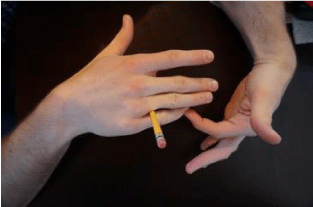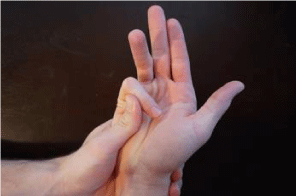Annals of Musculoskeletal Medicine
Outcomes of Extra-Octave Fractures in children
Colton Ryan* and William Hennrikus
Cite this as
Ryan C, Hennrikus W (2019) Outcomes of Extra-Octave Fractures in children. Ann Musculoskelet Med 3(2): 011-013. DOI: 10.17352/amm.000017Background: There are limited studies differentiating between the two main treatment options for Extra-Octave fractures. The purpose of the present study is to report the outcomes when treating the Extra-Octave fracture in children.
Methods: 12 small finger proximal phalanx fractures Salter-Harris type II were treated. Patient records were obtained via IRB protocol and were examined retrospectively. Reduction was done via a pencil technique or a 90/90-flexion technique.
Findings: There were 5 female and 7 male patients. Average age was 9.8 years (range 4 to 13). There were 4 right injuries and 8 left injuries. The mechanisms of injury were 4 ball vs finger, 4 fall, and 4 miscellaneous injuries. Average time from injury to evaluation was 5.7 days. 8 fractures were nondisplaced and were treated with buddy taping. 4 fractures were displaced; 2 fractures were treated using the 90/90 method, one of which had failed the pencil method. 1 was treated by the pencil method. 1 patient demonstrated an unstable reduction and was treated with closed reduction percutaneous pinning. 6 patients gained full ROM. 1 patient who was treated using the pencil method had some decreased ROM. Length of follow up was on average 23 days after treatment.
Conclusions: Non-displaced fractures of the small finger proximal phalanx can be treated without reduction using buddy tape. There is no difference in time to recovery between the buddy tape and reduction groups, and the displaced fracture can be reduced by either the pencil or 90/90 method. Surgery is rarely needed. In conclusion, the outcomes of nondisplaced fractures are excellent. The outcome of displaced fractures is good to excellent. The displaced fractures should be reduced using one of the two reduction methods. The pencil method or the 90/90 method can be applied with equal success and outcomes.
Introduction
Hand fractures are common in children. Of those fractures, Salter Harris type II fractures are commonly seen in the proximal phalanx [1]. One specific proximal phalanx fracture at the base of the small finger with lateral deviation was first characterized by Mercer Rang and coined the “Extra-Octave” fracture because of the advantage for piano players to reach an extra octave, if the fracture is not reduced [2] (Figure 1). Salter explained that angular forces applied to the finger are usually the cause of phalangeal fractures [3]. Although this specific fracture has been well characterized, outcomes regarding the treatment options for this injury are lacking. Current understanding of treatment for this type of fracture is based on degree of angulation and orientation of the fracture. Non-displaced fractures can be treated by simply buddy taping the fracture to the adjacent finger until the fracture is no longer tender, typically 3-4 weeks [4-6]. Displaced fractures can be reduced by one of two methods. “The pencil method” was first described by Beatty et al, using a pencil as a fulcrum in the 4th web space to regain alignment [4]. The second method is deemed the 90/90-flexion technique [4,7-9]. Data comparing treatment methods is limited [10]. The purpose of the present study is to report the outcomes when treating the Extra-Octave fracture in children.
Materials and Methods
This study was approved by PennState College of Medicine Institutional Review Board (IRB). The patients were a consecutive series selected from the senior author’s clinic, “WH” in 2016. 12 small finger proximal phalanx fractures Salter-Harris type II were treated. Radiographs and medical records for the patients were obtained and examined retrospectively. Mechanism of injury, time from management to recovery, immobilization time, extent of recovery, and method of reduction was recorded. The pencil technique and the 90/90-flexion techniques were compared.
Results
There were 5 female and 7 male patients. Average age was 9.8 (range 4 to 13 years). There were 4 right-sided injuries and 8 left-sided injuries. There were 7 right hand dominant, 3 left handed, and 2 unknowns. Mechanisms of injury were categorized into three distinct groups. Injuries involving a fall accounted for 33%, ball injuries 33%, and trauma related injuries another 33%. Average time from injury to evaluation was 5.7 days. 8 patients had non-displaced fractures and did not undergo reduction were treated with buddy taping. Of those 8 patients, 3 had an additional splint. 3 patients had displaced fractures and were given a digital nerve block using 0.25% Marcaine. 2 patients were treated using the 90/90 method, one of which had failed the pencil method and 1 treated by pencil method. 1 patient who failed closed reduction was treated using closed reduction percutaneous pinning. The last patient failed closed reduction and was treated using percutaneous pinning with general anesthesia (Table 1). Average time of immobilization was 23.7 days. Average time to last follow up was 26 days. 6 of the patients treated returned to full ROM, 1 patient who was treated using the pencil method had 25% decreased ROM, 5 patients were lost to follow up.
Discussion
We are re-emphasizing the importance of recognizing and treating this common fracture and highlighting Dr. Mercer Rang’s unique name “the extra octave fracture”. Our data correlates with the most recent literature in several respects. Nearly all-current articles indicate that males sustained hand fractures more frequently than females [5,9,11-18]. In our review 58% of cases were male. The peak age of phalangeal fractures usually occurs between the age 9 and 12 [9]. The mean age of our review was 9.8 years old and the mode was 11 years old. Average time to recovery for all treatment groups was 26 days, which falls within the expected 3-4 week recovery period for most pediatric hand fractures [7,8]. Many of the extra-octave fractures could be treated without reduction, 67%, which is similar to other articles [19].
Rang concluded that the deformity caused by this fracture could pose an advantage to the aspiring pianist. Lateral deviation of the 5th digit allows for greater mobility will playing the piano, resulting in an extra octave of reach (Figure 2). Of the 12 patient charts reviewed in this study only 1 patient had any reduced motion in the injured phalanx. This patient was treated using the pencil technique. There does not seem to be an obvious advantage to using any one of the reduction methods, the 90/90-flexion or the pencil method are successful.
The 90/90-flexion method works by placing the MCP joint into flexion thereby tightening the collateral ligaments and applying force in the volar direction over the metacarpal shaft in a dorsal direction over the flexed PAP joint [20,21] (Figure 3). The pencil technique uses a pencil in the web-space as a fulcrum while applying traction, flexing the MP joint and then adducting the distal phalanx [2,21] (Figure 4).
Pediatric hand extra-octave fractures are very common injuries in children and both reduction techniques worked. If dealt with appropriately pediatric hand extra-octave fractures have excellent outcomes. Non-displaced fractures of the small finger proximal phalanx can be treated without reduction using buddy tape. There is no difference in time to recovery between the buddy tape and reduction groups. The displaced fracture can be reduced by either the pencil or 90/90 method. None of the patients went on to be concert pianists.
Conclusion
In conclusion, the outcomes of nondisplaced fractures are excellent. The outcome of displaced fractures is good to excellent. The displaced fractures should be reduced using one of the two reduction methods. The pencil method or the 90/90 method can be applied with equal success and outcomes.
- Nofsinger CC, Wolfe SW (2002) Common pediatric hand fractures. Curr Opin Pediatr 14: 42-45. Link: http://bit.ly/2Hk4VZc
- Rang Mercer (1983) "The Extra-octave Fracture of the Little Finger." Children's Fractures. Philadelphia: Lippincott 225-227
- Mahabir RC, Kazemi AR, Cannon WG, Courtemanche DJ (2001) Pediatric hand fractures: a review. Pediatr Emerg Care 17: 153-156. Link: http://bit.ly/2NvjY5Y
- Beatty E, Light TR, Belsole RJ, Ogden JA (1990 ) Wrist and hand skeletal injuries in children. Hand clin 6: 723-738. Link: http://bit.ly/2L4MVmN
- Mahabir RC, Kazemi AR, Cannon WG, Courtemanche DJ (2001) Pediatric hand fractures: a review. Pediatr Emerg Care 17: 153-156. Link: http://bit.ly/2NvjY5Y
- Wood VE (1976) Fractures of the Hand in Children. Orthopedic Clinics of North America 7: 528-529.
- Al-Qattan MM (2002) Juxta-epiphyseal fractures of the base of the proximal phalanx of the fingers in children and adolescents. J Hand Surg Br 27: 24-30. Link: http://bit.ly/31XNTbb
- Al-Qattan MM, Al-Zahrani K, Al-Boukai AA (2008) The relative incidence of fractures at the base of the proximal phalanx of the fingers in children. J Hand Surg Eur 33: 465-468. Link: http://bit.ly/2zejaKD
- Hastings H, Simmons BP (1984) Hand Fractures in Children. A statistical analysis. Clinical orthopedics and related research 188: 120-130. Link: http://bit.ly/2KOO8Qf
- Nellans KW, Chung KC (2013) Pediatric hand fractures. Hand clinics 29: 569-578. Link: http://bit.ly/2Mv70pt
- Cornwall R, Ricchetti ET (2006) Pediatric phalanx fractures: unique challenges and pitfalls. Clin Orthop Relat Res 445: 146-156. Link: http://bit.ly/2Hjy6vq
- Fischer MD, McElfresh EC (1994) Physeal and periphyseal injuries of the hand. Patterns of injury and results of treatment. Hand clin 10: 287-301. Link: http://bit.ly/2L4zov8
- Flynn JM, Skaggs DL, Waters PM (2014) Rockwood and Wilkins' fractures in children. Lippincott Williams and Wilkins 1252. Link: http://bit.ly/2KOaAZO
- Freedman EL, Vander Griend RA, Dell PC (1998)Tendon interposition in a juxta-epiphyseal fracture of the proximal phalanx. The J Hand Surg Br 23: 558-559. Link: http://bit.ly/2KPT9rL
- Neil GE, Marce F (1998) Swiontkowski. Pediatric Fractures of the Forearm, Wrist, and Hand. Skeletal Trauma in Children. Philadelphia: W.B. Saunders 246-247.
- Hofmeister EP, Kim J, Shin AY (2008) Comparison of 2 methods of immobilization of fifth metacarpal neck fractures: a prospective randomized study. J Hand Surg Am 33: 1362-1368. Link: http://bit.ly/2P7zbNe
- Innis PC (1995) Office evaluation and treatment of finger and hand injuries in children. Curr Opin Pediatr 7: 83-87. Link: http://bit.ly/2Mw9yn6
- Lindley Sheila G, Rulewicz G (2006) Hand fractures and dislocations in the developing skeleton. Hand clinics 22: 253-268. Link: http://bit.ly/2Z71RdG
- Leonard MH, Dubravcik P (1970) Management of fractured fingers in the child. Clinical orthopedics and related research 73: 160-168. Link: http://bit.ly/2ZllBFU
- Strickland JW, Graham TJ (2005) Fixation of Fractures in the Child's Hand." The Hand. Philadelphia: Lippincott Williams and Wilkins 141.
- Rockwood CA (1996) Upper Extremity. Fractures in Children. Philadelphia U.a.: Lippincott, 2001.
Article Alerts
Subscribe to our articles alerts and stay tuned.
 This work is licensed under a Creative Commons Attribution 4.0 International License.
This work is licensed under a Creative Commons Attribution 4.0 International License.





 Save to Mendeley
Save to Mendeley
